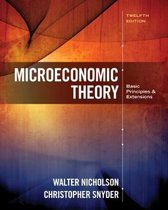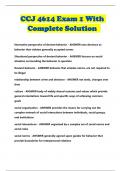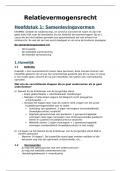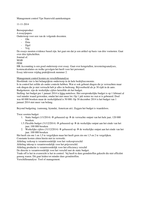The Market System
Adam Smith had two key parts in his discussion of self-interest:
i) Decentralization – people are not being instructed or explicitly coordinated
ii) Greed – they do not care about the people that they are producing for/trading with
The market system is a way of producing goods allocating resources to people using price signals.
We refer to a “system” because we are looking at the whole economy and how it works, rather than
any specific sector or market.
There are many debates about the merits of markets and what they achieve → we want our models
to give some insight into these issues.
This forces us to think about what we value in human welfare → efficiency, equity, freedom etc.
Standard Model
- 𝑀 people labelled by 𝑖
- 𝑁 goods labelled by 𝑗
- Each person has “talents” which can be deployed to generate income
- People have preferences: 𝑈 𝑖 (𝐱 𝑖 , 𝐿𝑖 ), where 𝐱 𝑖 = (𝑥1𝑖 , … , 𝑥𝑁𝑖 ) is consumption, 𝐿𝑖 is labour
supply → conventional assumption: people like goods and dislike work
- Throughout the course, we’ll focus on the case of just two goods, and two people
o This will suffice to illustrate the main ideas
What is a good?
Goods may not just be things that we conventionally recognize as goods (we’ll treat services as
goods here). A good can be different according to where and when you consume it:
- Cake on 2nd January 2020 may enter your utility differently to cake on 21st January 2020
o So, they are distinct goods
- And prices could vary if supply and demand for cake need to be equalized on different dates
There are complete markets when all possible variants of goods and services can be traded.
Market Goods
The focus is on those things that are traded at defined prices.
- Statistical agencies collect price data in markets and data on what people buy and produce
- These are used to get measures of aggregate activity in the market economy → important
for guiding policy
The non-market sector is also important:
- Home production
- Government production
- Some parts of the non-profit sector
,Incomes – An Exchange Economy
- Individuals have endowments of goods
o Although unrealistic, we’ll explore some aspects of allocative efficiency and equity
issues in this framework
o Also allows us to draw the classic Edgeworth Box
o There’s no supply-side of the economy as such → people have ownership of
quantities of goods
o The only issue will be how people trade given those endowments, through the
market economy
- Total endowment of good 𝑗 is 𝑍𝑗
- Let 𝜎𝑖𝑗 ∈ [0,1] be individual 𝑖’s share of the endowment of good 𝑗 with ∑𝑖 𝜎𝑖𝑗 = 1 for all 𝑗
o i.e. for two people: 𝜎𝐴𝑗 + 𝜎𝐵𝑗 = 1
o Think of 𝜎𝑖𝑗 defining the distribution of property rights, according to who owns what
in the economy before trade begins
- Then, income of 𝑖 is: 𝑚𝑖 = ∑𝑗 𝑝𝑗 𝜎𝑖𝑗 𝑍𝑗
o i.e. income of 𝑖 = prices × shares of endowment × total endowments
Incomes – A Production Economy
- A simple model of this is where income is generated by supplying labour
- Suppose that each individual 𝑖 has a talent for producing one good, denoted by 𝑎𝑖𝑗
o They produce that good, then sell that good at the market price to generate income
- Then, income of 𝑖 is: 𝑚𝑖 = 𝑎𝑖𝑗 𝑝𝑗 𝐿𝑖
o We can think of 𝑎𝑖𝑗 𝑝𝑗 as an individual’s wage rate
- The supply of good 𝑗 is: 𝑍𝑗 = ∑𝑖 𝑎𝑖𝑗 𝐿𝑖
o We’re using the convention that 𝑎𝑖𝑗 = 0 when individual 𝑖 has no talent for
producing good 𝑗
Consumption and Labour Supply
This is standard and follows the approach from last term:
- An individual 𝑖 will choose their consumption and labour supply to maximize 𝑈 𝑖 (𝐱 𝑖 , 𝐿𝑖 )
subject to ∑𝑗 𝑥𝑗𝑖 𝑝𝑗 ≤ 𝑚𝑖 ⇒ ∑𝑗 𝑥𝑗𝑖 𝑝𝑗 ≤ 𝑎𝑖𝑗 𝑝𝑗 𝐿𝑖 (in a production economy)
- This yields their demand for each good:
𝑥̂𝑗𝑖 = 𝑓 𝑖 (𝑝1 , … , 𝑝𝑁 , 𝑎𝑖𝑗 )
𝐿̂𝑗𝑖 = 𝑔𝑖 (𝑝1 , … , 𝑝𝑁 , 𝑎𝑖𝑗 )
- Goods can be complements or substitutes
The Whole Economy
Then, demand for a good is just the sum of the demands by all individuals:
𝑋𝑗 (𝑝1 , … , 𝑝𝑁 , 𝐚) = ∑𝑀 𝑖
𝑖=1 𝑓 (𝑝1 , … , 𝑝𝑁 , 𝑎𝑖𝑗 ), where 𝐚 = (𝑎11 , … , 𝑎𝑀𝑁 ) is the vector of talents in the
economy.
Similarly, the output of each good is the sum of the supply of labour by all individuals:
𝑍𝑗 (𝑝1 , … , 𝑝𝑁 , 𝐚) = ∑𝑀 𝑖
𝑖=1 𝑔 (𝑝1 , … , 𝑝𝑁 , 𝑎𝑖𝑗 )
So, now we can ask about resource allocation in the economy as a whole. In particular, how prices
are determined.
,General Equilibrium
Prices are set so as to “clear” all markets simultaneously:
- Consumers are able to get what they want given these prices
- Given the distribution of talents, the market delivers enough goods to provide for what
consumers want
- We’ll denote the equilibrium prices as 𝐩∗ = (𝑝1∗ , … , 𝑝𝑁∗ )
The best way to think about this is in terms of excess demand:
- Let 𝐸𝑗 (𝑝1 , … , 𝑝𝑁 , 𝐚) = 𝑋𝑗 (𝑝1 , … , 𝑝𝑁 , 𝐚) − 𝑍𝑗 (𝑝1 , … , 𝑝𝑁 , 𝐚) be excess demand for good 𝑗
- There are 𝑁 of these equations (one for each good)
- When markets clear, all excess demands are zero
Intuition about excess demand functions:
- Suppose that there are more people who are able to produce a particular good
o Excess demand will fall for any given price
o We’d then expect the market clearing price to fall
o But it will also affect markets for complements and substitutes for that good
- If a good becomes popular:
o Excess demand for that good increases
o We’d expect the market clearing price to rise
o It will affect other markets which are complements or substitutes
We can think of the aggregate economy as representing the sum of all activity:
- Aggregate demand: ∑ 𝑝𝑗∗ 𝑋𝑗 (𝑝1∗ , … , 𝑝𝑁∗ , 𝐚)
- Aggregate supply: ∑ 𝑝𝑗∗ 𝑍𝑗 (𝑝1∗ , … , 𝑝𝑁∗ , 𝐚)
But the economy can also be looked at in terms of sectoral aggregates e.g. agricultural share:
∑𝐾∈{agricultural goods} 𝑝𝐾 𝑍𝐾 (𝑝1∗ , … , 𝑝𝑁∗ , 𝐚)
∑𝑘∈{all goods} 𝑝𝑘 𝑍𝑘 (𝑝1∗ , … , 𝑝𝑁∗ , 𝐚)
Price Normalization and Walras’ Law
Price normalization:
- A general equilibrium can be expressed entirely in terms of a numeraire good since only
relative prices matter
- But the choice of numeraire is arbitrary → we can set 𝑝𝑘 = 1 for any 𝑘
o Look at example below to see how this is used
Walras Law:
- If all but one market is in equilibrium, then so is the last one
- To see this, set 𝑝1 = 1 and then note that: 𝑋1 + ∑𝑁 𝑁
𝑗=2 𝑝𝑗 𝑋𝑗 = 𝑍1 + ∑𝑗=2 𝑝𝑗 𝑍𝑗
- So, if ∑𝑁 𝑁
𝑗=2 𝑝𝑗 𝑋𝑗 = ∑𝑗=2 𝑝𝑗 𝑍𝑗 , then 𝑋1 = 𝑍1
, Example
- Consider an economy where two individuals 𝐴 and 𝐵 consume two goods labelled 1 and 2
- Let (𝑥1𝐴 , 𝑥2𝐴 ) and (𝑥1𝐵 , 𝑥2𝐵 ) be the consumption of individuals 𝐴 and 𝐵
- Individual 1 has 𝑍1 units of 𝑥1 and individual 2 has 𝑍2 units of 𝑥2
o This is an endowment economy where one individual owns the whole stock of one
good (i.e. 𝜎𝐴1 = 1, 𝜎𝐵1 = 0 and 𝜎𝐴2 = 0, 𝜎𝐵2 = 1)
- Let the price of good 1 be 𝑝1 and the price of good 2 be 𝑝2
- Preferences for 𝐴 are: 𝑥1𝐴 + 4√𝑥2𝐴
- Preferences for 𝐵 are: 2√𝑥1𝐵 + 𝑥2𝐵
What are the equilibrium prices? Four steps:
1. Make life easy by using the fact that we can set 𝑝1 = 1 (using price normalization)
2. Solve for demand functions
3. Set supply equal to demand for one of the goods (using Walras Law)
4. Solve for prices
Solve for demand functions
- Set 𝑝1 = 1
- Then, for 𝐴 use the budget constraint 𝑝1 𝑥1𝐴 + 𝑝2 𝑥2𝐴 ≤ 𝑝1 𝑍1 to derive: 𝑥1𝐴 = 𝑍1 − 𝑥2𝐴 𝑝2
𝑥𝐵
- Then, for 𝐵 we use 𝑝1 𝑥1𝐵 + 𝑝2 𝑥2𝐵 ≤ 𝑝2 𝑍2 to derive: 𝑥2𝐵 = 𝑍2 − 𝑝1
2
o Found 𝑥1𝐴 and 𝑥2𝐵 as these need to be subbed back into the utility functions, and the
FOC is easier to derive since there’s no roots involved (which would not have been
the case if we had instead found 𝑥2𝐴 and 𝑥1𝐵 )
For individual 𝐴:
- Substitute the budget constraint into the utility function to get that the demand for good 2
solves: 𝑥2𝐴 = arg max {𝑍1 − 𝑥2𝐴 𝑝2 + 4√𝑥2𝐴 }
1
−
- The FOC is: −𝑝2 + 2(𝑥2𝐴 ) 2 =0
1 2
- Then, demand for good 2 is: 𝑥2𝐴 = 4 (𝑝 )
2
4
- And demand for good 1 is: 𝑥1𝐴 = 𝑍1 − 𝑥2𝐴 𝑝2 = 𝑍1 −
𝑝2
Doing the same for individual 𝐵:
𝑥𝐵
- 𝑥1𝐵 = arg max {2√𝑥1𝐵 + 𝑍2 − 𝑝1 }
2
1
1
- FOC: (𝑥1𝐵 )−2 − =0
𝑝2
- Then, demand for good 1 is: 𝑥1𝐵 = (𝑝2 )2
𝑥𝐵
- And demand for good 2 is: 𝑥2𝐵 = 𝑍2 − 𝑝1 = 𝑍2 − 𝑝2
2











